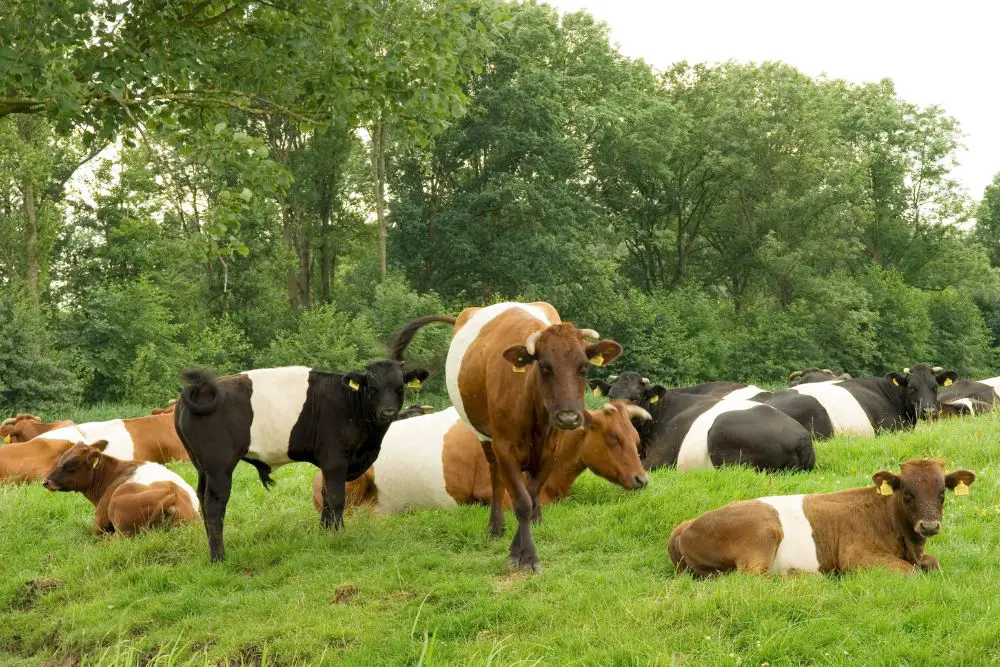Lakenvelder cattle are a rare breed that is primarily used as dairy cows and were so named because “Laken” means sheet in Dutch. The wide white belt around the middle of their bodies gives them a distinctive appearance among farm animals.
This article takes a deeper look at this unique breed that few people have ever seen.
Table of Contents
Where Does The Lakenvelder Cattle Come From?
Lakenvelder cattle are also known as Dutch Belt Cows and are a rare breed of dairy cattle from Holland in the Netherlands.
Their ancestors were the belted cows native to Austria and Switzerland which were first imported by Dutch nobility in the 17th century. D.H. Haight was responsible for the importation of Lakenvelders to the United States in 1838.
Dutch Belted breeds were quickly noticed in North America for their looks, and P.T. Barnum bought Dutch belted cows for his circus in America in the 1840s.
The Dutch Belted Cattle Association of America created a herdbook for the breed in 1886 and remains the oldest operating registry for Lakenvelders.
Lakenvelder cattle are listed as critical according to the American Livestock Breeds Conservancy, with a total worldwide population of less than 1,000.
Lakenvelder Cattle Breed Characteristics
| Official Breed Name | Lakenvelder Cattle |
| Scientific Name | Bos (primigenius) taurus |
| Origin | The Netherlands |
| Appearance | The most notable physical characteristic is their color pattern, featuring a thick white belt around their midsection which is flanked on either side by black or red. |
| Calf Weight | 70lbs |
| Mature Cow Weight | 900 to 1500lbs |
| Mature Cow Height | 4 feet |
| Mature Bull Weight | 1500 to 2000lbs |
| Mature Bull Height | 4.5 feet |
| Ready To Breed | 12 to 15 months |
| Gestation Period | 283 days |
| First Calvings | 2 years with 10 month lactation period |
| Time to Slaughter | 6 to 9 months |
| Expected Lifespan | 18 to 22 years |
| Productive Lifespan | 5+ years |
| Known For | Prolific fertility, milk production and breed longer than most other dairy cows |
| Weaknesses | Very few breeders due to rarity and a small gene pool |
| Climate | Do best in cooler climates with mild winters |

What Is So Special About Lakenvelder Cattle?
Lakenvelder cows are known to be more fertile than Holsteins and rarely have reproductive issues.
They produce milk that is partially homogenized due to fat globules being naturally small and this makes their milk easy to digest. Their milk has a butterfat content of 3.5 to 5.5%.
In crossbreeding Lakenvelders with stockier breeds, a higher meat yield can be obtained than with other dairy breeds, making Lakenvelders a dual-purpose cattle.
Why Should I Raise Lakenvelder Cattle On My Farm?
- Farmsteads will benefit from having Lakenvelder cattle because of their dual-purpose possibility
- Known for milk production and producing milk that is desirable for drinking and making cheese
- Breeders have strict breed standards they adhere to
- Calves are known for being vigorous and healthy
- Calves can continue to be produced by Lakenvelders into old age
- Docile temperament makes for easy handling by novices
- No known health concerns with Lakenvelder cattle
- They are excellent foragers saving on food costs
